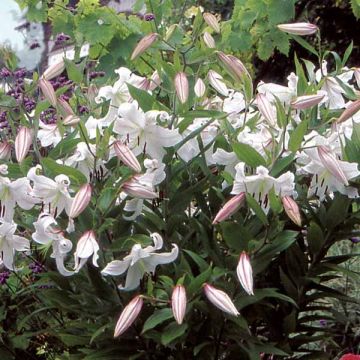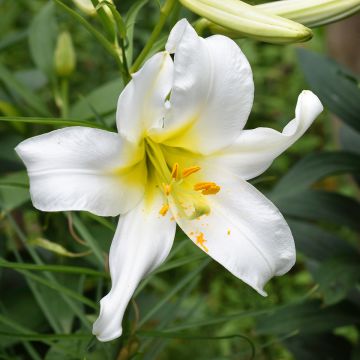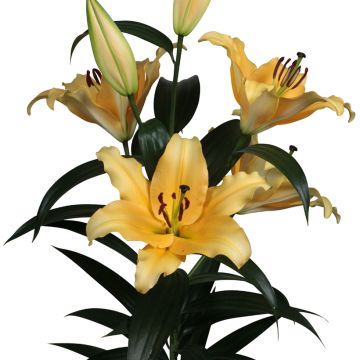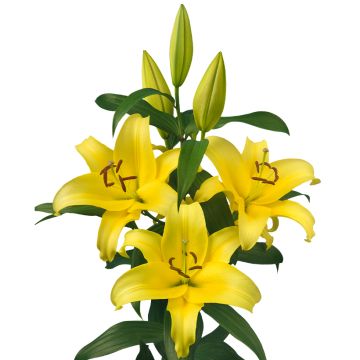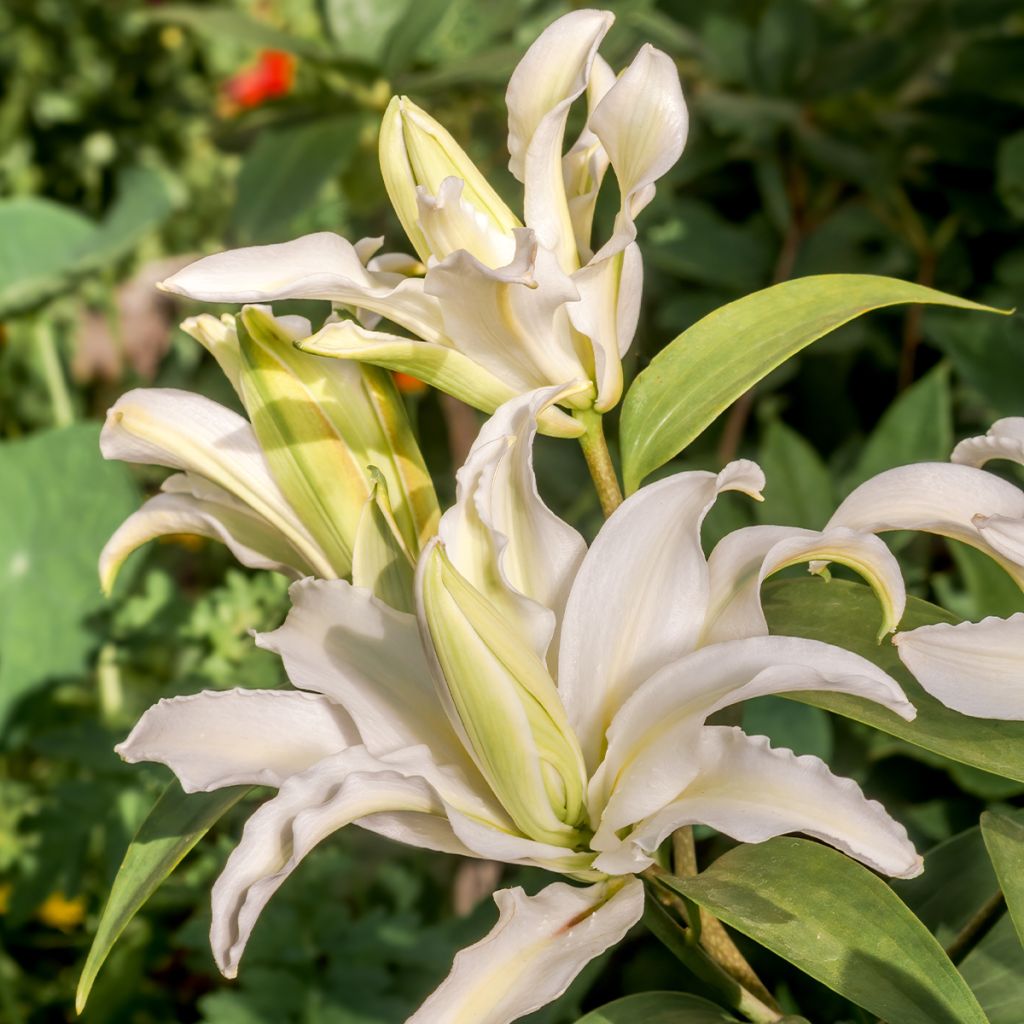

Lilium oriental Polar Star - Lily


Lilium oriental Polar Star - Lily
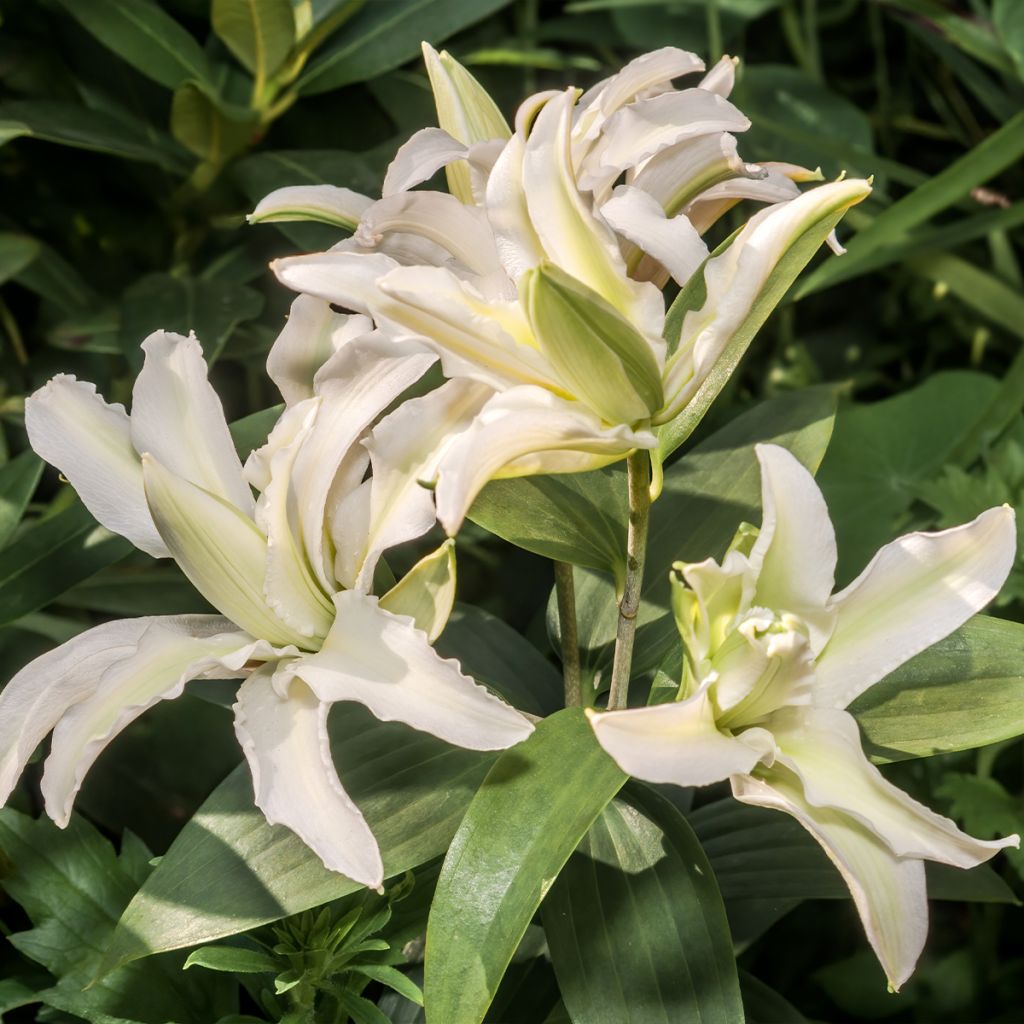

Lilium oriental Polar Star - Lily


Lilium oriental Polar Star - Lily
Lilium oriental Polar Star - Lily
Lilium oriental Polar Star
Oriental Lily
Good evening! These lily bulbs have arrived in good condition and have already been planted. Now all I have to do is wait for their flowering and their fragrance.
Françoise Marie, 25/05/2021
Why not try an alternative variety in stock?
View all →This plant carries a 6 months recovery warranty
More information
We guarantee the quality of our plants for a full growing cycle, and will replace at our expense any plant that fails to recover under normal climatic and planting conditions.
From €5.90 for pickup delivery and €6.90 for home delivery
Express home delivery from €8.90.

Does this plant fit my garden?
Set up your Plantfit profile →
Description
The 'Polar Star' Oriental Lily is an unusual variety that is both elegant and charming: its flowers are double, white with a hint of green in the centre, and pleasantly fragrant. It blooms quite late, reaching its peak in August-September. Perfect in a white garden, this lily also pairs well with all colours in the garden. Its cut flowers are perfect for special occasions.
The genus Lillium belongs to the lily family, its representatives are bulbous plants whose foliage disappears in winter. In spring, leafy stems emerge from the ground and form a narrow and upright clump. 'Polar Star' is a horticultural hybrid introduced in 2012. Like all lilies in the Oriental group, it was obtained through cross-breeding various species native to the Far East. This plant will reach a minimum height of 70cm (28in) when in bloom, and it will grow taller over the years. The clump will also spread indefinitely over time, with the bulbs producing bulblets through vegetative multiplication. In August, more or less early depending on the climate, umbels of 15cm (6in) in diameter flowers appear, more or less upright or directed outward, beautifully displayed. They lack stamens and are composed of multiple undulate and reflexed petals, often folded like a gutter, which gradually unfold from the outer to the inner part of the corolla. The heart of the corolla and some petals are animated by a green glow. The stems are strong, covered with alternate, dark green, shiny, and lanceolate leaves.
Oriental lilies are plants that thrive in humus-rich soil, they do not tolerate calcareous, poorly drained, and heavy soils, and they are slightly more difficult to grow than Asian lilies if the conditions are not met. You can associate them with perennial plants as they appreciate having shade at their base. The perennial plants will also help prevent the stems from bending under the weight of the flowers or due to the wind. 'Polar Star' is well-suited for pot cultivation, which can be placed on the terrace, near entrances, or in high-traffic areas to fully enjoy its unusual and fragrant flowering. This lily is also ideal in a low shrub border, and of course in bouquets. For example, you can pair it with compact hydrangeas, Pieris, Chinese azaleas, dwarf rhododendrons in a large non-calcareous soil bed.
Lily pollen is known to stain clothes: this 'Polar Star' variety, without stamens and pollen, does not have this drawback. Therefore, it is a remarkable cut flower in every way.
Report an error about the product description
Lilium oriental Polar Star - Lily in pictures


Plant habit
Flowering
Foliage
Botanical data
Lilium
oriental
Polar Star
Liliaceae
Oriental Lily
Cultivar or hybrid
Other Lilies A to Z
Planting and care
The 'Polar Star' lily does not appreciate calcareous, poorly drained, and heavy soils. You will install it in full sun, with the base in the shade, preferably in spring, burying the bulbs 15cm (6in) deep in a pocket of soil mixed with leaf compost. Surround them with a pocket of sand that will prevent rotting and attacks from slugs, while allowing them to grow more easily. Mark the planting location, as vegetation only starts in April. When the stems reach 30cm (12in) tall, discreetly stake them.
If red insects appear, treat them immediately, as they are beetles whose larvae can devour all the leaves. The most effective method is to catch them manually, but be careful as they drop as soon as they are touched, so put a box underneath.
After flowering, it is useful to cut the faded flowers halfway to keep the bed beautiful during the summer.
Tip for planting lilies in compact soil: The scaly bulbs of large lilies are afraid of clay soils that suffocate them and cause rotting. In Eastern Europe, the following technique is used to help these bulbs survive the winter. Plant them on 'benches' built above ground level. These benches consist of a first layer of gravel, on which tightly packed branches are placed. Then cover everything with a thick layer of compost 20 to 30cm (8 to 12in) deep. Plant the bulbs in the compost, on which a few ground-covering plants can also crawl.
On the terrace, you can create sumptuous pots with lilies. Choose a container that is large and deep enough (at least 16cm (6in) in diameter for 1 bulb). Fill it with a mixture of leaf compost and sand. Plant the lilies in groups of 3 to 5 bulbs, 10-15cm (4-6in) apart, then water abundantly. Place the pots in a cool room or outside once the frost has passed. The ambient temperature should be around 12°C (53.6°F). When shoots appear, move the pot to a veranda or a very bright room, at a temperature of about 18°C (64.4°F). Make liquid fertilizer applications twice a month until the appearance of flower buds.
Planting period
Intended location
Care
-
, onOrder confirmed
Reply from on Promesse de fleurs
Haven't found what you were looking for?
Hardiness is the lowest winter temperature a plant can endure without suffering serious damage or even dying. However, hardiness is affected by location (a sheltered area, such as a patio), protection (winter cover) and soil type (hardiness is improved by well-drained soil).

Photo Sharing Terms & Conditions
In order to encourage gardeners to interact and share their experiences, Promesse de fleurs offers various media enabling content to be uploaded onto its Site - in particular via the ‘Photo sharing’ module.
The User agrees to refrain from:
- Posting any content that is illegal, prejudicial, insulting, racist, inciteful to hatred, revisionist, contrary to public decency, that infringes on privacy or on the privacy rights of third parties, in particular the publicity rights of persons and goods, intellectual property rights, or the right to privacy.
- Submitting content on behalf of a third party;
- Impersonate the identity of a third party and/or publish any personal information about a third party;
In general, the User undertakes to refrain from any unethical behaviour.
All Content (in particular text, comments, files, images, photos, videos, creative works, etc.), which may be subject to property or intellectual property rights, image or other private rights, shall remain the property of the User, subject to the limited rights granted by the terms of the licence granted by Promesse de fleurs as stated below. Users are at liberty to publish or not to publish such Content on the Site, notably via the ‘Photo Sharing’ facility, and accept that this Content shall be made public and freely accessible, notably on the Internet.
Users further acknowledge, undertake to have ,and guarantee that they hold all necessary rights and permissions to publish such material on the Site, in particular with regard to the legislation in force pertaining to any privacy, property, intellectual property, image, or contractual rights, or rights of any other nature. By publishing such Content on the Site, Users acknowledge accepting full liability as publishers of the Content within the meaning of the law, and grant Promesse de fleurs, free of charge, an inclusive, worldwide licence for the said Content for the entire duration of its publication, including all reproduction, representation, up/downloading, displaying, performing, transmission, and storage rights.
Users also grant permission for their name to be linked to the Content and accept that this link may not always be made available.
By engaging in posting material, Users consent to their Content becoming automatically accessible on the Internet, in particular on other sites and/or blogs and/or web pages of the Promesse de fleurs site, including in particular social pages and the Promesse de fleurs catalogue.
Users may secure the removal of entrusted content free of charge by issuing a simple request via our contact form.
The flowering period indicated on our website applies to countries and regions located in USDA zone 8 (France, the United Kingdom, Ireland, the Netherlands, etc.)
It will vary according to where you live:
- In zones 9 to 10 (Italy, Spain, Greece, etc.), flowering will occur about 2 to 4 weeks earlier.
- In zones 6 to 7 (Germany, Poland, Slovenia, and lower mountainous regions), flowering will be delayed by 2 to 3 weeks.
- In zone 5 (Central Europe, Scandinavia), blooming will be delayed by 3 to 5 weeks.
In temperate climates, pruning of spring-flowering shrubs (forsythia, spireas, etc.) should be done just after flowering.
Pruning of summer-flowering shrubs (Indian Lilac, Perovskia, etc.) can be done in winter or spring.
In cold regions as well as with frost-sensitive plants, avoid pruning too early when severe frosts may still occur.
The planting period indicated on our website applies to countries and regions located in USDA zone 8 (France, United Kingdom, Ireland, Netherlands).
It will vary according to where you live:
- In Mediterranean zones (Marseille, Madrid, Milan, etc.), autumn and winter are the best planting periods.
- In continental zones (Strasbourg, Munich, Vienna, etc.), delay planting by 2 to 3 weeks in spring and bring it forward by 2 to 4 weeks in autumn.
- In mountainous regions (the Alps, Pyrenees, Carpathians, etc.), it is best to plant in late spring (May-June) or late summer (August-September).
The harvesting period indicated on our website applies to countries and regions in USDA zone 8 (France, England, Ireland, the Netherlands).
In colder areas (Scandinavia, Poland, Austria...) fruit and vegetable harvests are likely to be delayed by 3-4 weeks.
In warmer areas (Italy, Spain, Greece, etc.), harvesting will probably take place earlier, depending on weather conditions.
The sowing periods indicated on our website apply to countries and regions within USDA Zone 8 (France, UK, Ireland, Netherlands).
In colder areas (Scandinavia, Poland, Austria...), delay any outdoor sowing by 3-4 weeks, or sow under glass.
In warmer climes (Italy, Spain, Greece, etc.), bring outdoor sowing forward by a few weeks.

































